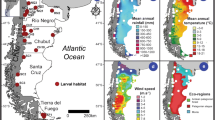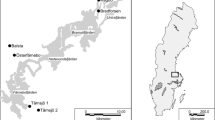Abstract
The temporal fluctuation of water levels and the presence of mosquito larvae were investigated for four types of small container habitats (treeholes, bamboo stumps, cemetery stone vases, and cemetery stone vessels) on Kabeshima Island in Kyushu, southwestern Japan. The probability that containers held water was positively correlated with the quantity of the preceding rainfall and with the depth and volume of the containers. It was estimated that dehydration occurred more regularly in autumn and winter than in summer. The probability that mosquito larvae were present in each type of container was positively correlated with habitat stability in terms of the probability of the existence of standing water and the coefficient of variation of the water level. Twelve species of mosquito larvae, including two rare predators, were found. Species composition differed between the different types of container. Although 4 to 10 species used each type of container, the median number of species per container was two for treeholes and bamboo stumps, and one for the others. The dominant species wasTripteroides bambusa in treeholes and bamboo stumps,Aedes albopictus in stone vases, andA. japonicus in stone vessels. The larval mosquito community, which lacked major predators, possessed the following features that may facilitate the coexistence of many species: (1) niche segregation amongst species in terms of their selection of container types; (2) an aggregated distribution of the individual species among containers of the same type; (3) high intraspecific mean crowding (and hence probably intense intraspecific competition) in the dominant species in each type of container; (4) independent species associations within the same type of container; and (5) low interspecific mean crowding (and hence probablynot intense interspecific competition) between species in the same type of container.
Similar content being viewed by others
References
Arakawa, R., M. Watanabe and K. Kamimura (1990) Seasonal prevalence of mosquitoes breeding in the forest area at Mt. Tateyama in Toyama Prefecture.Annu. Rep. Health. Inst. Toyama Pref. 13: 70–75.
Atkinson, W. D. and B. Shorrocks (1981) Competition on a divided and ephemeral resource: a simulation model.J. Arim. Ecol. 50: 461–471.
Bradshaw, W. E. and C. M. Holzapfel (1983) Predator-mediated, non-equilibrium coexistence of tree-hole mosquitoes in southeastern North America.Oecologia 57: 239–256.
Bradshaw, W. E. and C. M. Holzapfel (1986) Habitat segregation among European tree-hole mosquitoes.Nat. Geogr. Res. 2: 167–178.
Bradshaw, W. E. and C. M. Holzapfel (1988) Drought and the organization of tree-hole mosquito communities.Oecologia 74: 507–514.
Bradshaw, W. E. and C. M. Holzapfel (1992) Reproductive consequences of density-dependent size variation in the pitcherplant mosquito,Wyeomyia smithii (Diptera: Culicidae).Ann. Entomol. Soc. Am. 85: 274–281.
Chambers, R. C. (1985) Competition and predation among larvae of three species of treehole breeding mosquitoes. pp. 25–53.In Lounibos, L. P., J. R. Rey and J. H. Erank (eds.),Ecology of mosquitoes: proceedings of a workshop. Florida Medical Entomology Laboratory, Vero Beach, Florida.
Chesson, P. L. and N. Huntly (1988) Community consequences of life-history traits in a variable environment.Ann. Zool. Fenn. 25: 5–16.
Fisher, I. J., W. E. Bradshaw and C. Kammeyer (1990) Fitness and its correlates assessed by intra- and interspecific interactions among tree-hole mosquitoes.J. Anim. Ecol. 59: 819–829.
Hanski, I. (1981) Coexistence of competitors in patchy environment with and without predation.Oikos 37: 306–312.
Hard, J. J., W. E. Bradshaw and D. J. Malarkey (1989) Resource-and density-dependent development in tree-hole mosquitoes.Oikos 54: 137–144.
Hurlbert, S. H. (1969) A coefficient of interspecific association.Ecology 50: 1–9.
Ives, A. R. (1988) Aggregation and the coexistence of competitors.Ann. Zool. Fenn. 25: 75–88.
Ives, A. R. and R. May (1985) Competition within and between species in a patchy environment: relations between microscopic and marcroscopic models.J. Theor. Biol. 15: 65–92.
Kingsolver, J. G. (1979) Thermal and hydric aspects of environmental heterogeneity in the pitcher plant mosquito.Ecol. Monogr. 49: 357–376.
Kuno, E. (1988) Aggregation pattern of individuals and the outcomes of competition within and between species: differential equation models.Res. Popul. Ecol. 30: 107–121.
Kulasekera, V. L. and E. P. Amerasinghe (1990) A survey of the mosquito fauna (Diptera: Culicidae) of Shiharaja Forest, Sri Lanka.Ceylon. J. Sci. (Biol. Sci.) 21: 55–74.
Lloyd, M. (1967) ‘Mean crowding’,J. Anim. Ecol. 36: 1–30.
Lounibos, L. P. (1979) Temporal and spatial distribution, growth, and predatory behaviour ofToxorhynchites brevipalpis (Diptera: Culicidae) on the Kenya coast.J. Anim. Ecol. 48: 213–236.
Lounibos, L. P. (1981) Habitat segregation among African treehole mosquitoes.Ecol. Entomol. 6: 129–154.
Lounibos, L. P. (1983) The mosquito community of treeholes in subtropical Florida. pp. 223–246.In J. H. Frank and L. P. Lounibos (eds.)Phytotelmata: terrestrial plants as hosts for aquatic insect communities. Plexus, Medford, New Jersey.
Lounibos, L. P. (1985) Interactions influencing production of treehole mosquitoes in south Florida. pp. 65–77.In Lounibos, L. P., J. R. Rey and J. H. Frank (eds.)Ecology of mosquitoes: proceedings of a workshop. Florida Medical Entomology Laboratory, Vero Beach, Florida.
Mogi, M. and H. Suzuki (1983) The biotic community in the water-filled internode of bamboos in Nagasaki, Japan, with special reference to mosquito ecology.Jap. J. Ecol. 33: 271–279.
Mogi, M. and H. S. Yong (1992) Aquatic arthropod communities inNepenthes pitchers: the role of niche differentiation, aggregation, predation and competition in community organization.Oecologia 90: 172–184.
Mori, A. (1979) Effects of larval density and nutrition on some attributes of immature and adultAedes albopictus.Trop. Med. 21: 85–103.
National Astronomical Observatory (1991)Rika nenpyo (Chronological scientific tables), Maruzen, Tokyo.
Ratliff, R. D. (1982) A correction of Cole's C7 and Hurlbert's C8 coefficients of interspecific association.Ecology 63: 1605–1606.
Rosewell, J., B. Shorrocks and K. Edwards (1990) Competition on a divided and ephemeral resource: testing the assumptions. I. Aggregation.J. Anim. Ecol. 59: 977–1001.
Sakakibara, M. (1960) On the seasonal distributions of the larvae ofAnopheles (A.) omorii and nine other mosquito species found in a tree hole.Endemic. Dis. Bull. Nagasaki Univ. 2: 236–242.
Shorrocks, B., W. Atkinson and P. Charlesworth (1979) Competition on a divided and ephemeral resource.J. Anim. Ecol. 48: 899–908.
Shorrocks, B., J. Rosewell and K. Edwards (1990) Competition on a divided and ephemeral resource: testing the assumptions. II. Association.J. Anim. Ecol. 59: 1003–1017.
Simpson, E. H. (1949) Measurements of diversityNature 163: 688.
Sota, T. (1993) Performance ofAedes albopictus andA. riversi larvae (Diptera: Culicidae) in waters that contain tannic acid and decaying leaves: is the treehole species better adapted to treehole water?Ann. Entomol. Soc. Am. 86: 450–457.
Sota, T. and M. Mogi (1992a) Interspecific variation in desiccation survival time ofAedes (Stegomyia) mosquito eggs is correlated with habitat and egg size.Oecologia 90: 353–358.
Sota, T. and M. Mogi (1992b) Survival time and resistance to desiccation of diapause and non-diapause eggs of temperateAedes (Stegomyia) mosquitoes.Entomol. Exp. Appl. 63: 155–161.
Sota, T., M. Mogi and E. Hayamizu, (1992) Seasonal distribution and habitat selection byAedes albopictus andAe. riversi (Diptera: Culicidae) in northern Kyushu, Japan.J. Med. Entomol. 29: 296–304.
Southwood, T. R. E. (1978)Ecological methods 2nd ed. Chapman & Hall, London.
Tanaka, K., K. Mizusawa and E. S. Saugstad (1979) A revision of the adult and larval mosquitoes of Japan (including the Ryukyu Archipelago and the Ogasawara Islands) and Korea (D9ptera: Culicidae).Contr. Am. Entomol. Inst. 16: 1–987.
Watanabe, N., (1988) A new proposal for measurement of the adjusted mean crowding through consideration of size variability in habitat units.Res. Popul. Ecol. 30: 215–225.
Yasuda, H. and T. Mitsui (1992) Laboratory observations of prey behaviour for prey acquisition by a predator among three larval mosquitoes.Ecol. Res. 7: 179–182.
Author information
Authors and Affiliations
Rights and permissions
About this article
Cite this article
Sota, T., Mogi, M. & Hayamizu, E. Habitat stability and the larval mosquito community in treeholes and other containers on a temperate Island. Res Popul Ecol 36, 93–104 (1994). https://doi.org/10.1007/BF02515090
Received:
Accepted:
Issue Date:
DOI: https://doi.org/10.1007/BF02515090




